Industry Roundtable
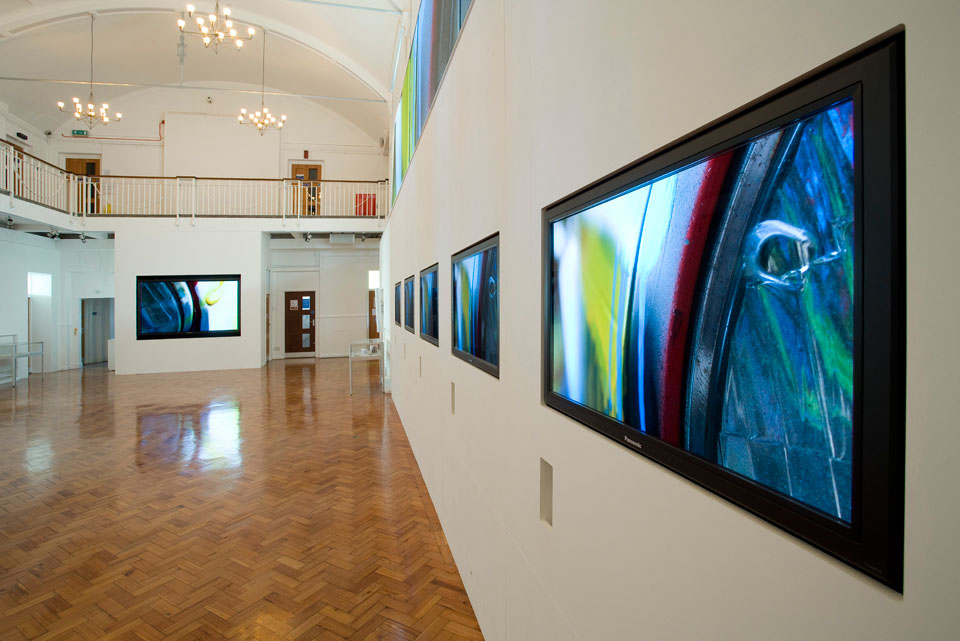
Top Digital Signage and DOOH experts analyze the state of the industry as we head into 2012.
Editor's Note: The following article appears in the Digital Signage Resource Directory. A digital copy of the magazine can be found here: www.nxtbook.com/nxtbooks/newbay/ds_20110910/
The First Ten Years are Always the Hardest
The Digital Signage and DOOH State of the Union

David Keene, Executive Editor
The Experts' Perspectives
Lyle Bunn on Sourcing
A daily selection of the top stories for AV integrators, resellers and consultants. Sign up below.

Lyle Bunn is one of North America’s top digital signage experts and industry consultants.
- “But the 50% annual growth in the post 9/11 economy has leveled to an annual growth rate of about 20% over the past several years,” explained Bunn. “The inability of many suppliers to provide planning input to the suitable use of the medium, and to provide a more informed and comprehensive perspective of the digital place-based media application has hurt the natural momentum of this enabling capability.”
- So as the market has changed, many ask: When you pitch a digital signage rollout to and end-user, do you target the CIO? The head of IT? The head of Marketing? Is this marketing confusion being sorted out? How far have we come in ten years toward having a market that is “mature” in the sense of an orderly path to market for digital signage solutions?
- Lyle Bunn explains “the early industry practice of selling to a line manager or franchisee has provided demonstration projects for the use of digital signage for patron, visitor and staff communications. Required investment levels and ROI proposition have been demystified for digital signage serving as a stand-alone application. But as the medium seeks to scale for broader enterprise application, which involves the CIO or VP Information Technologies and their use of System Development Life Cycle (SDLC) methodologies, the game has changed. While many industry providers are painting themselves into a ‘technology supplier’ corner and failing to meet the new challenge, it provides excellent market opportunities for others.”
- In addition to and related to the challenge of the lack of an efficient market mechanism where sellers and buyers of digital signage can reliably meet under the same tent, the nature of producing and managing “content” puts the digital signage market on a different plane than any other commercial AV market. Traditional AV providers have not historically been in the “Content” business. Traditionally AV providers laid down the bandwidth/switching/delivery/display hardware, and then the end user placed relatively static content in the system. But digital signage is different, because it’s about “dynamic” content– content that needs to be some combination of interactive touch screen, environmentally-triggered content, data-mining, store-and-forward, content-effectiveness-measured, with video analytics, etc. How does that Content management aspect of digital signage make the typical AV integrator’s role different in this market (as opposed to the traditional AV market)? Digital Signage Content Management Software– is it a minefield, or a great opportunity to upsell your services if you’re an integrator?
Brad Gleeson on Content Management Systems

Brad Gleeson, Executive VP and GM, Digital Out-of-Home, at Chilin Solutions
“Content Management Software is both the great enabler and the most difficult and confusing segment of the industry value chain right now,” says Brad Gleeson, Executive VP and GM, Digital Out-of-Home, at Chilin Solutions. “The plethora of offerings, with SAAS models, Cloud-based solutions, Windows vs. Linux, analytics, interactivity, and on and on, make it nearly impossible for new prospects considering adding digital media into their advertising or merchandising strategy to confidently evaluate and select a platform.”
“It is a great opportunity if you’re an expert in the software, but I’ve seen very few AV companies make the investment and staff their organization correctly to deliver effective digital signage implementations,” says David Levin of Four Winds Interactive, a digital signage content management software provider.
As complex as the selection of Digital Signage Content Management Software is, in terms of being able to launch a digital signage system with compelling content, the greater challenge is ensuring that the content on the screens is compelling a year after the launch. That is why we’ve heard a lot this past year about “Managed Services” for digital signage– in other words, there is a big need now for companies to provide the management of the digital signage system after it is installed. How is this playing out? Will it change the digital signage landscape?
“Many customers want to outsource the design, management and operations of their digital media network,” explains Brad Gleeson. “The complexity of these options make it more attractive for retailers, venue owners and media companies to turn the network operations over to experts, with the experience and bandwidth to guarantee performance and up-time. Some companies will always want to control this in house, and some IT folks will demand it, but in reality the transition to cloud computing and the move to outsourcing other previously strategic functions will accelerate the acceptance and growth of Digital Signage as managed service. In reality, the dominant market shapers for digital signage in the future could end up being the managed service providers rather than software providers or system integrators. If an efficient, professional, global managed service company decides to make digital signage strategic and can gather a couple of very large companies to play along, this could become the defacto standard. The wild card is and will always be content, which by definition is creative and therefore not ‘manageable’.”
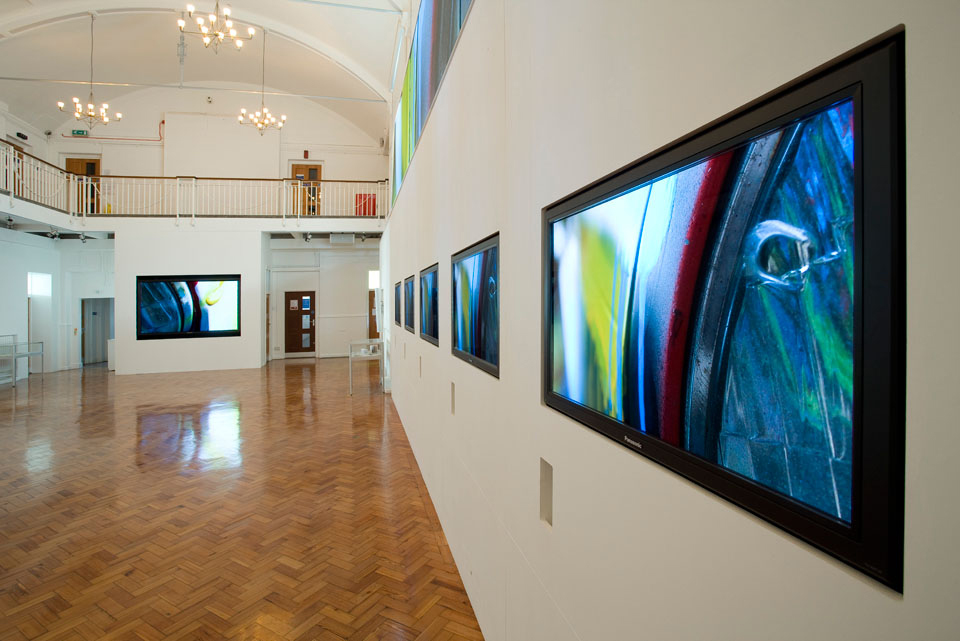
A new digital signage system manages the display of content in the Ruskin Digital Gallery, that opened in May 2011 at the Anglia Ruskin University, Cambridge Campus, UK. Content seamlessly flows from screen to screen via a dedicated fiber and copper based AV LAN that was commissioned by Snelling Business Systems. (photo courtesy of Dataton).
On a practical level, this really gets back to the need–seen in every technology adoption cycle– to increase recurring revenues for providers, not just one-time design/installation/rollout fees.
“The natural course for AV/IT integrators (and other emerging suppliers) is to maximize the number of digital signage services provided and total billings per application”, says Lyle Bunn. “Recurring costs such as network support, playlist administration, content creation and others offer such revenues to integrators, while simultaneously providing high value to end users– a win-win situation for the industry. End users of dynamic signage are interested in any approach that can turn capital expenditures into operating expense, and staffing expense to outsourcing, while assuring continuous supply. Network supply based on location agreements has served the industry well. As this approach continues to evolve, the economies that managed services can provide will make it increasingly attractive.”
Of course no assessment of the digital signage industry would be complete without a look at the latest developments in the retail world– the use of digital signage in the retail space, as a shopper engagement tool. Unlike the corporate, education, transportation worlds, where digital signage can be more about information delivery not tied to sales or measured for strict ROI, the retail store and the related DOOH (Digital Out of Home) spaces are about branding, marketing, and sales of products. So in-store digital signage is–fairly or not– evaluated as another potential “network”, like a new TV channel would be. Who saw the ad? For how long? Did it influence their shopping behavior?
How far have we come, in the goal of being able to deliver to brands and/or retailers, an in-store digital network that is as robust and compelling a platform than the other more established platforms those brands and retailers can spend their money on (TV, and Internet primarily)?
Laura Davis Taylor on Shopper Engagement

Laura Davis Taylor is Senior Vice President, Managing Director, at BBDO ShopWork
“We are not there… but we’re getting there,” says Laura Davis Taylor, Senior Vice President, Managing Director, BBDO ShopWork. “There are two hurdles from the advertising point of view: mass reach and measurability. We have made huge strides with reach, as digital signage has finally become an embraced tool to spend money on. Heck, you even see the little counter digital signs in mom and pop cafés these days! But being able to cleanly link an ad on a digital sign to metrics regarding how many looked at it and how many then bought is still not there. It is also not possible to tie it behavioral data residing in mobile and online channels that shopper may have engaged in. As P&G says, ‘we fund well what we measure well’. When we make digital

The use of digital signage for retail, including the QSR market, remains the holy grail for many digital signage providers. (Photo courtesy of Planar.)signage as measureable as other established digital tools, we’ll be humming. We will also be delivering incredibly valuable shopper insights to retail brands—something they are all dying for”
While digital signage as an in-store network has been ramping up, though, out of the gates, fast came Smartphones and Tablets. Why would brands and retailers not just jettison “digital signage” and cut to the chase: right to the smartphones in shoppers’ hands, bypassing all our industry’s big shiny screens hanging in a store a lot of which have static, boring content?
“Because signs still work,” says Taylor. “Done right, they break through the clutter with a ‘beacon message’ in a crowded store. They can get the attention of the distracted shopper and remind her in a glance that there’s a product she might want to check out. They serve this purpose well, especially when they can be targeted by store profile and time of day. Mobile is opt in…interactive is opt in. Both are a two-step process. Digital signs are right there with a ‘look at me’ message. It’s good signage on steroids and it only takes a 1-2 second look to produce results.”
Jeff Dickey on DOOH

Jeff Dickey has been involved in DOOH since its inception. He was one of the founders of SeeSaw Networks. He is currently on the Board of Directors of StarMount.
“While brands and retailers are quickly adopting the new technology,” comments Jeff Dickey, “this doesn’t necessarily discount the value of DOOH in the retail environment — it just changes the way it should be utilized. In retail, DOOH should be part of a general effort to relate to customers, creating an environment that should be replicated in both online and mobile touch points. Effectively, this creates the online/offline brand immersion that can be leveraged to strengthen the retailer/consumer relationship. It acts as one leg of a three-legged stool that, in turn, becomes a solid platform from which to market and merchandise.”
Of course, the world of advertising, and retail, and brands, is all about Metrics. Companies like Nielsen and Arbitron have been providing for decades metrics on who is seeing what TV, Print, Internet Ads, when and where. Brands and Ad agencies use these metrics in a perennial pricing/billings dance that revolves around CPM (the adverting cost per thousand views), and with the birth of in-store networks based on digital signage, it’s natural for them to want to apply the same metrics to in-store. But Metrics are a two-edged sword when it comes to in-store digital– they promise a lot, but they also threaten a lot of players in the retail and advertising worlds. If Metrics are deteriorating in traditional media– why should this new in-store, and DOOH, media, be held to a higher standard? Is that higher standard a move to promote in-store digital, and DOOH, or stall it? Many in the traditional agency camps especially feel threatened by in store digital signage– because it’s a wild card that no one controls yet, and because they’re not sure how to buy it, and bill it. What “Metric” initiatives are really needed for in-store digital signage, and DOOH, and which are smokescreens thrown up to stall in-store digital and DOOH by people who feel threatened by it?
“This is one of the many ‘elephant in the room’ issues that the old guard and the new guard are eyeing cautiously,” says Laura Davis-Taylor. “The old guard is indeed threatened that they may lose creative, planning and media dollars. They like their traditional media tools that are measured by brand benchmarking (awareness and perception) and not results. The new guard sees it as a huge opportunity to activate targeted media thinking into the store and put their marketing thinking to test. To do so confidently, however, they would need to measure—and connect—what they are doing offline, online and in-store. As I’ve said often, this should not be threatening because knowledge is power. If you see that your digital marketing isn’t working to engage people and sell, change it up!”
“But it can get a bit more complicated for a traditional agency with no shopper marketing chops,” continues Laura. “To be confident and accountable to a campaign that flows ‘through the line’ across all channels you have to understand the difference between marketing to consumers and marketing to shoppers. It’s the same person, but they have very different needs and very different things are going on as you are trying to move them to action. This may be the bigger issue. Smart shopper strategists know what they are doing and how to use digital signage and every other shopper aperture. They live for measurement. Non-savvy practitioners of course don’t want measurement…they’ll be rooted out as not knowing what they are doing. This issue will work itself out. The new guard will show us the way.”
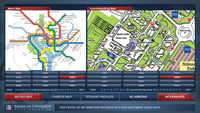
Wayfinding is one of the main uses of digital signage on campuses, in malls, and other locations. This unique application on the campus of American University combines wayfinding with student profiles, internship information, and more. (Photo courtesy of Four Winds Interactive.)
But the role of digital signage in the larger world of brands and marketing, and retail, is not all about measurable sales lift. Ad agency people, Brands, and retailers always speak the speak. It will always be about metrics, CPM, and results. But year after year, the sales of displays, and content management services, into the retail world increases significantly, even as the complex metrics issues are not worked out. How do you explain this? The fact is, even in the world of retail, and corporate branding and marketing, history shows that many campaigns were more about “image advertising” than about sales lift. In fact, most of the traditional advertising campaigns in previous decades were about brand building, not sales lift. And it’s fair to say that a lot of consumers don’t and will not like intrusive use of digital signage to pitch them products in public places.
“The movie Minority Report pointed– in an exaggerated Hollywood fashion– to one extreme of one-to-one advertising and marketing in public spaces with digital signage,” says Rick Cope, President & CEO, NanoLumens. “If you’re reading this, you’re an industry person– and when we’re talking about an anonymous shopper and someone is paying us to engage them, it's a great idea. But the ‘direct’ approach to engaging the consumer/user is not the only way. Do we deliver in a way that says, buy my product, buy it right now? Or, do we use the indirect approach and offer engagement that is more subtle, emotional and possibly more effective? The first principle in using the indirect approach with advertising is that the digital display needs to contain more than just advertising. Our advertising message will have to be more creative and intertwined and relevant to the other content being shown on the digital displays. “
The Providers' Perspectives
Enterprise-Wide Content Management for Higher Ed, Hospitality, Health Care, and Corporate Applications
Four Winds Interactive Pushes the Envelope for Content, and Managed ServicesFour Winds Interactive, based in Denver, Colorado (www.fourwindsinteractive.com), is one of the premier digital signage content management software providers. The Four Winds Interactive software solution is running more than 60,000 digital signage players worldwide. Major installations for Royal Caribbean International, Courtyard by Marriott Hotels, and the Cosmopolitan Las Vegas, are but a few of the many rollouts for which Four Winds provides content management software and support. Four Winds provides digital signage solutions for several industries including, Higher Education, Hospitality, Health Care, and Corporate.
NewBay Media’s David Keene spoke with Four Winds Interactive President David Levin, about their role in the industry, at this crucial juncture of market maturity.
David Keene:While it’s something of an oversimplification, it’s been useful when approaching digital signage content management software, to distinguish between two main camps of providers: Those who say that digital signage content management software should be cloud-based, SaaS, so “customers can take the best of what resides on the web and mash it into their SaaS content management provider’s application and content. And conversely, those who say any serious digital signage rollout should have premise-based digital signage content management software. Putting the “theoretical” argument aside, how do you see the market evolving now? What are the end-users you are talking to, wanting? Pure SaaS? More robust, premise-based systems?

David Levin, President, Four Winds Interactive
David Levin/Four Winds: There’s no question that the software market overall is evolving to cloud-based architectures. Storing content, data, and key parts of your architecture in the cloud makes a lot of sense for any customer, from small to large-enterprises. I believe the trend for digital signage content management systems will follow the overall software market, evolving to cloud-based architectures. I think it’s important to note that cloud-based architectures and client applications for content management are not mutually exclusive. Because an important part of content management systems for digital signage is design and end users are often working with large media files, I think a client application for content management is an important component of an overall digital signage software suite. There’s a reason that most content-rich applications (e.g., Photoshop, iTunes, etc.) are still client applications. The rich user interface of a client application often makes for a better user experience than browser-based applications. I think applications like iTunes or Evernote show the power of a hybrid client application with a cloud-based architecture.
In my experience, end users are focused more on capability of the software platform overall and less on the question of SaaS vs Premise. There are certainly some exceptions, but overall the conversations we have with prospects or clients are more about the overall capability of the product to support the increasing sophistication level in how the software is going to be used. They want to know what it can do first, then what the implementation options are. Different customers have different philosophies on premise-based vs. hosted solutions. Both models can work and both models have advantages and disadvantages. Often what it boils down to is identifying the specifics of the signage applications themselves. If the signage applications require integrations to third party systems that reside on the client’s network, then a premise-based model usually makes more sense. Generally speaking, as more enterprises move to cloud-based architectures, the hosted application will appeal to a broader audience.
David Keene:How does the Content management aspect of Digital Signage make the typical AV integrator’s role different in this market (as opposed to the traditional AV market– where the Integrator provide system design and installation, not content)? This question goes to Digital Signage Content Management Software– is it a minefield, or a great opportunity to upsell your services if you’re an integrator, in the AV channel?
David Levin: As the digital signage market has matured and continues to evolve, the applications of digital signage are becoming increasingly more complex. Even in industries where one would think the signage applications would be simple, we see customers pushing forward the request for functionality faster than ever. As the complexity and sophistication of the signage application increases, I think it’s more difficult for the traditional AV integrator to fulfill the requirement in a pure reseller model. For many implementations, I think the ideal solution includes the AV integrator and digital signage software company’s professional services team working closely together to deliver the end solution. “How does that Content management aspect of Digital Signage make the typical AV integrator’s role different in this market (as opposed to the traditional AV market)?” It makes their role different in that they need to be an expert in the software product they’re selling and have resources dedicated to implementing it and supporting it long-term. Or, develop a close relationship with a software company that has a good professional services team.
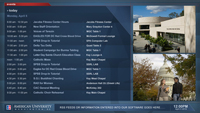

American University had other digital signage systems running prior to kicking off their project with Four Winds Interactive. But they wanted to move forward with a system that could support their expanded vision for signage on a campus-wide level. According to a recent student survey given by the University Center, digital signage– powered by the new Four Winds system, was the #1 method by which students found out about an event on campus, beating out Facebook, Twitter, and other social media and web options.“Is Digital Signage Content Management Software a minefield, or a great opportunity to upsell?” It is a great opportunity if you’re an expert in the software, but I’ve seen very few AV companies make the investment and staff their organization correctly to deliver effective digital signage implementations. The Integrator needs to really make the investment in time to evaluate the companies and the products. There are differences. AV Integrators could follow the same product selection methodologies of large end-users who often are successful at distinguishing the difference between real capability and unsubstantiated hype within the vendor community. I’d encourage AV Integrators to travel to visit the digital signage software companies in person. See the operation, meet the team, get trained in the software. Get a trial-version and use it. Integrators should sell or recommend the software product that they have the most experience with or they should choose the software company who they’ve worked with closely enough and know that they mesh well with the software company’s project management team. They either need to be able to say, “I know the software and I can implement it” or “I’ve worked with this company and we’ve implemented successful projects together.”
David Keene: We’ve heard a lot this past year about “Managed Services” for digital signage– in other words: there is a big need now for companies to provide the management of the digital signage system after it is installed. Is this the realm of the digital signage content management software provider? Of the Integrator?
David Levin: At Four Winds, we provide the GoBoard for Courtyard by Marriott on a Managed Services model. So, we manage the status of all the players, after installation. We have team of people to execute changes. We distribute content, on behalf of the brand. All of those services are “managed services”, which take the pain away from the end users and make implementing a network a more realistic possibility. So yes, that is the future of the industry, and we are there already.
David Keene:Your thoughts, on “the first ten years” of the industry– and where we stand today?
David Levin: Throughout the past 10 years, much of the industry has had an indirect go-to-market strategy through the AV channel. We’ve often taken the opposite approach and mostly worked directly with our customers in key industry verticals or worked with a few key partners who are dedicated to our product. It’s made a big difference for us in understanding many of the diverse applications for digital signage and developing the functionality to support all different applications. That being said, it’s very important for the AV channel to become more sophisticated about digital signage content management software. Integrators need to do what the most sophisticated end-user companies do: put together a score-card for software vendors; get presentations from vendors. Drill down to the complex questions, like, for a retail customer, “can we use the software with a Oracle sales data base?”
Three years ago, when you were pitching a digital signage installation, it was probably a new installation. Now, the prospect has probably used a system– maybe a system that is not implemented enterprise-wide. Or maybe they are unhappy with their current system and want to make a change. And so much has changed in a just a few years. Ten years ago, large format displays were expensive and they weren’t touch screens. Now they’re far more affordable and touch enabled. Ten years ago, the smart phone was just starting to emerge. Now everyone has one. Customers’ expectations of how to get information through digital displays has changed dramatically based on smart phone usage. This is going to change our industry dramatically. I think the question of what is a “digital sign” and what is just an App becomes very blurry. Moving forward, I see this driving a lot of change in our industry.For more information: www.fourwindsinteractive.com
Cisco Bridges Two Worlds, for High-Level Digital Signage
IT and AV Meet– to End-Users’ Benefit
Cisco has been well known in the larger IT world for decades. But the use of video across organizations is now more prevalent, making network-based digital signage solutions–not just standalone digital signage displays, or just data-centric IT networks– more important.
David Keene spoke with Cisco’s Janice Le Litvinoff. Janice is the General Manager of the Digital Media Systems Business Unit (DMSBU), one of Cisco’s enterprise video businesses. Cisco’s Digital Media business includes a comprehensive portfolio of software and hardware products that serve the following markets: digital signage, webcast/video sharing, and enterprise content delivery networks. Janice has many years of experience related to digital signage, digital media, streaming, content delivery networks, video production, and video management.
David Keene:How has Cisco seen the evolution from IT networks, to IT/video-rich networks? In other words, from the IT perspective, has the fact that Digital Signage really started from the AV side not the IT side, made for a problematic “first ten years”? And what is the prospect for overcoming those problems?
Janice Le Litvinoff, General Manager, Digital Media Systems Business Unit

It was quite problematic when IT didn’t see video as a priority because without IT support, it was difficult for line of businesses to scale beyond small pilots. So therefore, not being able to scale beyond a pilot made it difficult to justify ROI. You cannot leverage the scale of the investment and extend your reach to make it an attractive communications medium for content owners.
The good news is that IT is now embracing video like never before. It is becoming one of the top priorities in many organizations. At Cisco, we are uniquely positioned to bring together the IT and AV worlds.
David Keene:Last year, Cisco introduced a video architecture called medianet. So that “secure, intelligent network architectures would be able to manage multiple co-existing video applications–as networks are becoming more hybrid and interactive.” How is that rollout developing?
Not only does medianet simplify digital signage deployments but it also enables digital signage to integrate with content that can be streamed live or recorded from telepresence devices for town hall meetings or executive broadcasts.
David Keene:To what extent is Cisco involved in “Integration”? i.e not just providing hardware and software to a job, but acting as the integrator responsible for initial design, installation, maintenance, etc. of a Digital Signage rollout (as in a large sports stadium, for example). And how has this Integration role changed as the Digital Signage market has matured– or at least evolved in the past ten years?The Dallas Cowboys organization selected Cisco as a key supplier of enterprise-wide digital signage solutions in the new Cowboys Stadium, for delivering next-generation fan experiences and unique branding and promotion opportunities. Cisco-provided systems integrate and distribute high-definition video with digital content and interactive fan services to connect the Cowboys and the stadium with fans in entirely new ways.Janice Le Litvinoff: As with any other technology, Cisco is often expected to provide end-to-end solutions and services to customers and partners. Cisco has a world class services organization responsible for the planning, deploying, implementation and support services for all of our products, including digital signage. We also have a skilled advanced services team responsible for vertical integration, such as sports and entertainment, that allows customer to integrate signage along side of other applications and technology to deliver the best interactive video experiences with ease of management, security, predictability and scale.

In addition, Cisco also has an ecosystem of hundreds of application development partners who focus on verticals or specific customers who need a tailored solution. We actively manage this ecosystem to deliver on customer needs and partner profitability.
David Keene:Does Cisco market a line of Media Players or other pure hardware offerings for Digital Signage that are marketed where appropriate as stand-alone devices, not necessarily part of a large, enterprise-wide Cisco solution?
Janice Le Litvinoff: Our goal is to provide customers with flexible deployment options while ensuring that they can leverage the network to scale and deliver the best experience possible to digital signs. Customers have a choice to deploy an end-to-end Cisco solution or a partner integrated solution (e.g. ecosystem partner applications for content management) based on their needs.
David Keene:Cisco has large and well-established network of Integration Partners in the traditional IT world. For the Digital Signage market, is Cisco relying on those same partners, or seeking new Partners from the AV side?
Janice Le Litvinoff: Both IT and AV see value in providing integration in application services for signage. But there is also room for application developers in this market as well. So we help provide all three options to customers and which partners they use depends on the customers’ needs. There are many IT partners who have either grown or acquired AV skill sets, and vice versa, which is an indicator that both communities see tremendous opportunity for growth and profitability in this market, and they recognize they can’t do video without both the IT and AV expertise.
Adding the Human Touch to Digital Signage for Retail – “Get Personal”
Interactive Video Engagement from MediaTile Takes In-Store Digital to New Level
MediaTile Company, provider of cloud-based digital signage systems, has developed a next-generation “interactive video engagement” solution, called HumanKiosk, for point-of-sale or point-of-service environments. The goal is to allow businesses to humanize their brand interaction, improve the customer experience, and deliver their messages with absolute control, using expert interaction from remote locations. Well beyond the demo stage– MediaTile has already signed on a broad ecosystem of solution partners and is already doing some innovative pilots. Sprint and MediaTile announced in early October 2011 the commercial availability of MediaTile's HumanKiosk Solution (powered by the company's MediaCast Video Presence system) that accesses Sprint's speedy 4G high-bandwidth network; a Verizon Wireless announcement will have also been made by the time this article has been released)
MediaTile’s HumanKiosk platform stands at a confluence of several trends: SaaS management of content; Cellular delivery of content; and the combination of live “human” interaction with pre-programmed digital signage content. This is really unique: combining programmed, dynamic content with live shopper/brand agent interaction. The solution is display hardware-agnostic for both the Kiosk and the agent console. For example, on the “agent end” i.e. the end where the “brand agent” is fielding live queries from an in-store shopper, it is browser-based–you can video enable existing standard equipment, allowing agents to be located remotely (e.g. home based) as well as in call centers. Agents could even use a Windows-based Tablet.
Simon Wilson, CEO of MediaTile, explained the go to market strategy for this next generation of digital signage/DOOH platform for this Industry Roundtable.

Simon Wilson, CEO, MediaTile
“It’s important to step back and define the goal of this new platform, not with technical jargon, but with its role in shopper marketing, branding, and the consumer experience,” explains Wilson. “To expand the addressable market for digital signage, we have to understand the paradigm shift from B2C to “B2Me”. B2C (business to consumer) is a shotgun approach with little effectiveness, only delivering generic information to anonymous audiences. All business is now personal in the digital age. Consumers expect facts and information to be tailored to them while shopping, working, banking, attending events, even while in transit. B2Me, or Business-to-Me, is user or buyer-initiated interaction, conversation, inquiry or communication. With a B2Me solution, customers engage in a personal dialog – when and where they need it most. And this is not some hypothetical goal. Our HumanKiosk, powered by MediaCast Video Presence, enables localization and personalization through the fusion of interactive digital signage capabilities with simple to use on-demand, face-to-face video interaction.”
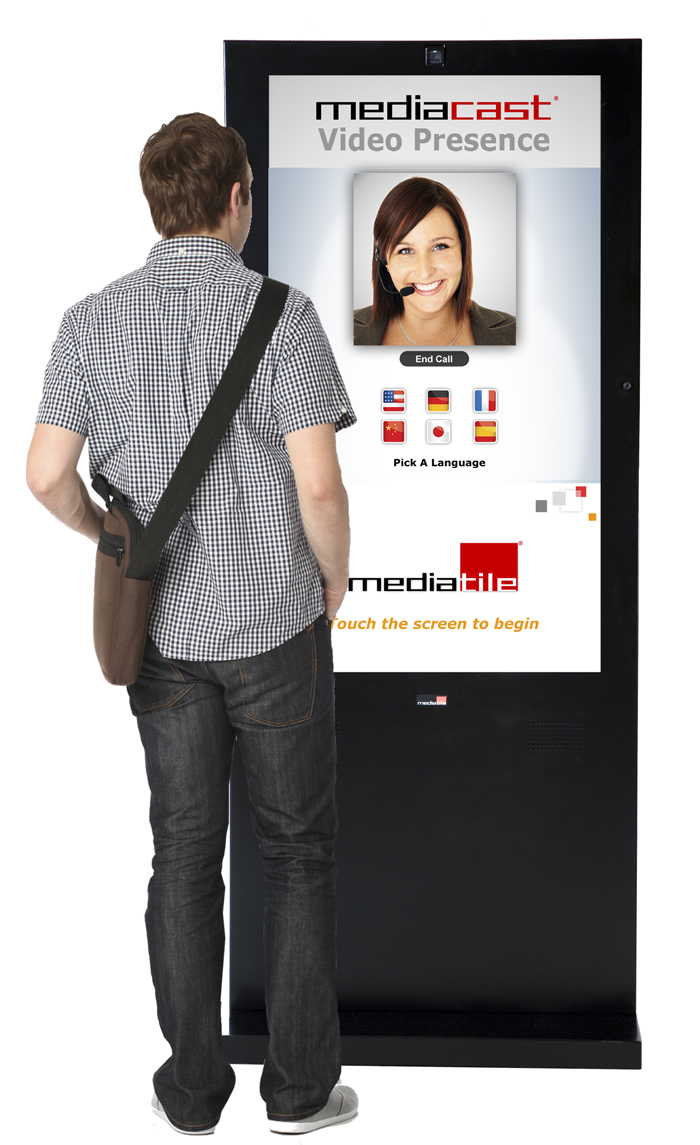
Using the HumanKiosk platform, a shopper walks into a store, but instead of getting the some canned content shown them, they can interact, via the screen, with touch-screen content and a real person, a real expert that can help them shop at that moment.It’s important to emphasize Wilson’s last point. Using the HumanKiosk platform, a shopper walks into a store. They approach a digital display. But instead of getting the some canned content shown them, they can interact with the content, via the screen, and in addition access a real expert that can help them shop at that moment. The underlying technology allows for instant matching of agent capabilities with a customer’s request, in real time. This intelligent video call routing software makes the user interface very simple to use for the consumer. In terms of the actual platform, MediaTile is developing a range of ecosystem partners. There are several hardware partners already signed on, so there are options in terms of display hardware. The system could work on a large screen, shelf mount, or custom fabrication – all Kiosks are based on the Wintel 7 platform. The brand/retail agent end is browser-based, so you could video enable existing call centers and standard PC/Mac equipment already in place.
So what is happening is, with the touch of an on-screen button, consumers instantly enter a 2-way, high-definition, face-to-face conversation with a remote expert. Remote experts support consumers directly, rather than solely relying on often poorly trained sales associates or other on-site intermediaries. These remote experts are available on-demand, and are automatically matched with the consumer’s on-screen selections, which might include product, specific features, services and/or language. The intelligent video call routing ensures that the customer receives a positive brand experience, and that they receive accurate, immediate, and relevant answers to their specific questions.
“With the HumanKiosk solution, brands are now able to engage consumers directly and take control of the brand-bias in the conversation,” explains Wilson. “And with an increasing need for metrics, the MediaCast Video Presence system also captures the consumer’s touch-based interactions. This provides an invaluable source of consumer intelligence data for brands, at a fraction of the cost, as compared to traditional interview methods such as on-site intercept or feedback polls.”
A self-contained and highly secure solution, the HumanKiosk includes built-in wireless network services from leading carriers. The HumanKiosk, therefore, requires nothing more than on-site power for operation. “Using the latest 4G / 4G LTE network services and cloud-based technology,” adds Wilson, “the system eliminates the need for on-site network costs and complexities, and avoids associated Internet intrusion threats.”
For more information: www.mediatile.com
Toward a New Paradigm for Content Display
By Rick Cope, President & CEO, NanoLumens
The Small Screen Grows Up– and So Does the Industry
Historically—and we're only talking about roughly a ten-year history—most digital signage has been about small LCD panels peppered in a mall, an airport, or some other public location. Sure, there have been larger screen options, but implementing a large screen usually entailed some combination of negative attributes like it was too expensive, too cumbersome, inflexible in terms of format and shape, and either too bright or not bright enough. If most digital signage is about small, cheap screens, what is the role for the maker of larger screens?
Larger displays are often used in a one-to-many format with the goal being brand messaging or brand reinforcement. One of the many advantages of large displays is that they are hard to miss! I believe our role at NanoLumens is to make displays that are simple for anyone to use while delivering the highest technology and function so that the user’s message is only limited by their imagination, and never by the technological limitations of the display. At NanoLumens, we are building the world’s first full line of large, flexible digital displays that are slim, lightweight, easy to install, energy-efficient and eco-friendly, and deliver superior image quality.
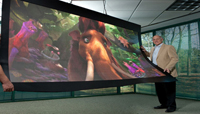
We believe that these types of displays empower retailers, corporations, advertisers, and owners of large public spaces such as convention halls and transit centers to make a big impact by using digital displays in ways and places that were previously impossible. Large digital signage displays are being implemented more and more, all the way up to projecting huge images onto the sides of buildings. But with all the digital signage options— LED, large-screen projection, large-screen LCD—how can the user sort out what is best for them? There are advantages and drawbacks to each technology. The user needs to consider their intention of use, the audience and the specifics of the display’s environment the display including viewing distance, ambient light, structural limitations and installation challenges.
NanoLumens currently uses LED technology because we are able to produce consistent, bright, rich, brilliant edge-to-edge picture quality on displays built to virtually any shape, size or flexibility, all the while eliminating the issues of a large footprint, weight, power consumption, etc. Also, aesthetics are becoming more and more important. We focus on making our displays sleek and attractive so that they add another level of beauty to the environment in which they are blended. We offer unique products from flexible digital wallpaper to displays wrapped in brushed aluminum casings, and even displays built in non-traditional shapes like circles, squares and triangles.
Another advantage of NanoLumens NanoFlex display is that it can become a mobile advertising platform, with users relocating it as they see fit for specific events or specific advertisers. Large screen or small, digital signage has always focused on fixed installation, not temporarily using screen and then relocating them. Customers increasingly want to highlight or accentuate a certain store or location and then have the ability to reuse that display in other locations. With the NanoLumens 112” NanoFlex display, users get a display that is light and easy to move or reinstall, so they can repurpose that display over and over again, generating significantly more ROI with a single display investment. In convention centers, for example, they host different events in different halls on different days, and we have provided them with a display solution that can moved from one location to another with very little time and effort. This allows them to minimize their capital expense while maximizing the displays’ exposure and value for trade shows and other events that utilize the venue.
For more information: www.nanolumens.com
The AVNetwork staff are storytellers focused on the professional audiovisual and technology industry. Their mission is to keep readers up-to-date on the latest AV/IT industry and product news, emerging trends, and inspiring installations.
